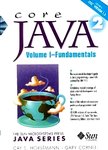版权所有:内蒙古大学图书馆 技术提供:维普资讯• 智图
内蒙古自治区呼和浩特市赛罕区大学西街235号 邮编: 010021

丛 书 名:The Sun Microsystems Press Java series
版本说明:5
I S B N:(纸本) 0130894680
出 版 社:Sun Microsystems Inc
出 版 年:2000年
页 数:2 v. :页
主 题 词:Java (Computer program language)
学科分类:08[工学] 0835[工学-软件工程] 081202[工学-计算机软件与理论] 0812[工学-计算机科学与技术(可授工学、理学学位)]
摘 要:From the Book: To the Reader In late 1995, the Java programming language burst onto the Internet scene and gained instant celebrity status. The promise of Java is that it will become the universal glue that connects users with information, whether that information comes from Web servers, databases, information providers, and any other imaginable source. Indeed Java is in a unique position to fulfill this promise. It is an extremely solidly engineered language that has gained acceptance by all major vendors, except for Microsoft. Its built-in security and safety features are reassuring both to programmers and to the users of Java programs. Java even has built-in support that makes advanced programming tasks, such as network programming, database connectivity, and multithreading, straightforward. Since then, Sun Microsystems has released four major revisions of the Java Software Development Kit. Version 1.02, released in 1996, supported database connectivity and distributed objects. Version 1.1, released in 1997, added a robust event model, internationalization, and the Java Beans component model. Version 1.2, released at the end of 1998, has numerous enhancements, but one major improvement stands out: the Swing user interface toolkit that finally allows programmers to write truly portable GUI applications. Version 1.3, released in the spring of 2000, delivered many incremental improvements. The book you have in your hand is the first volume of the fifth edition of the Core Java book. Each time, the book followed the release of the Java development kit as quickly as possible, and each time, we rewrote the book to take advantage of thenewest Java features. As with the previous editions of this book, we still target serious programmers who want to put Java to work on real projects. We still guarantee no nervous text or dancing tooth-shaped characters. We think of you, our reader, as a programmer with a solid background in a programming language. But you do not need to